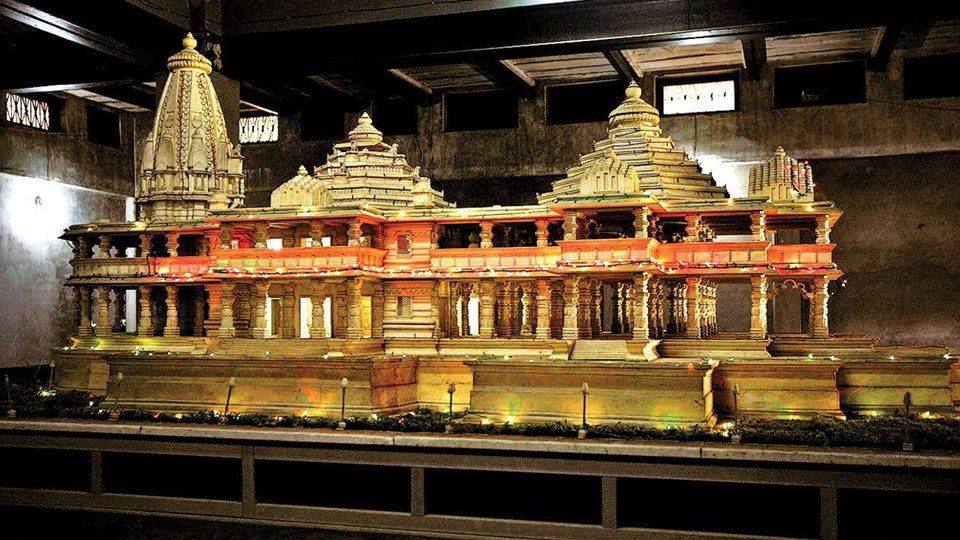New Delhi: Bringing down curtains on the Ram Janmabhoomi-Babri Masjid issue, one of the longest running title disputes in India, a Five-Judge Constitution Bench of the Supreme Court this morning, in a unanimous judgement, allotted the disputed Ayodhya land to the Ram Janmabhoomi Trust while ordering allotment of an alternative piece of five acres of land to the Muslims for a Mosque.
The Bench, headed by Chief Justice of India (CJI) Ranjan Gogoi, said the Hindu litigants were able to establish their case that they were in possession of the outer courtyard. It added that the Muslim side was unable to prove their exclusive possession of the inner courtyard. Sources said that the judgement runs into 1,045 pages.
The Apex Court has directed the Centre to frame a scheme under which it will constitute a body within three months to hand over the inner and outer courtyard to the Ram Janmabhoomi Trust. It said the Sunni Wakf Board would be granted five acres of land in a “suitable, prominent place in Ayodhya.”
Five-Judge Bench
The Chief Justice of India Ranjan Gogoi-led Bench of Justices Sharad Arvind Bobde, Dhananjaya Yeshwant Chandrachud, Ashok Bhushan and S. Abdul Nazeer, said that the damage caused to Babri Masjid in 1934 and the desecration in 1949 violates the rule of law. The demolition of the Babri Masjid in 1992 during the pendency of the suits is condemnable, the Bench said.
Muslims have not been able to prove their possession on the disputed property as a composite whole, the verdict said. “No proof to show Muslim possession was exclusive. The Sunni Waqf Board’s claim that the disputed premises were a Waqf is a mirror image of the Hindus’ claim that the Ram Janmabhoomi is a legal personality. Both contentions have been rejected,” the Bench ruled.
Allahabad HC verdict defies logic
The Supreme Court referred to Places of Worship (Special Provisions) Act, which prohibits conversion of any place of worship, to say that all religions are equal. At the heart of the Constitution is Secularism, commitment to equality. Constitution does not distinguish between one faith and another, said the Bench.
The Ayodhya title suit verdict came nine years after the 2:1 judgement of the Allahabad High Court that ordered a three-way division of the disputed 2.77 acres of land between the three parties — Ram Lalla, Sunni Waqf Board and the Nirmohi Akhara. The Lucknow Bench had ruled that Hindus and Muslims would be joint title holders of the disputed land. The SC Bench said that the three-way partition of the Ram Janmabhoomi by the Allahabad High Court defies logic.
SC accepts ASI findings: Accepting the Archaeological Survey of India’s (ASI) report, the Supreme Court stated that the Mosque was not constructed on vacant land. It observed, the pre-existing structure was large and Babri pillars prove a pre-existing structure. Pre-existing structure was not on Islamic land and the artefacts collected show earlier structure was non-Islamic.
“Balance of probabilities suggest pre-existence of temple. But the ASI has refrained from saying temple was demolished. It only says material was used for constructing Mosque. Both Hindus and Muslims cannot explain what the disputed land was used for from 12th to 16th century,” the Bench observed.
On faith of Hindus: On the faith of Hindus, the Supreme Court observed: “There is consistent proof that Hindus considered Ayodhya the birthplace of Ram. Hindus believed Ram was born under the central dome of the demolished Mosque. Testimonies, even in cross examination, did not disprove Hindus’ faith in birthplace as not genuine.”
“Once evidence is there of the belief and faith that Ram Janmabhoomi is the birthplace of Ram, the Court has to acknowledge it. It is beyond the ken of the Court to probe whether the belief is justified. Court cannot go by theology but only on evidence and balance of probabilities. There is historical evidence to prove the presence of worshippers at ‘Ram Chabutra’ and ‘Sita Rasoi’ and offering of prayers. This was a practice even before the British came. The adjudication of title is based on evidence and not travelogues, gazette entries,” the Judges observed.
“The construction of the railings on the premises was ostensibly to maintain peace. But the fact that Hindus leaned over the railings to offer worship at the direction of the Mosque’s central dome suggests their force of belief and faith that Ram was born there,” the Bench said.








Great news! This courts seem to be working for the first time on issues they postponed for 6 decades! Good they removed SPG cover to Gandhi clan so that they can talk nonsense at their own risk! First Article 370 and now Ayodhya!
Muslims tend to construct mosques in holiest places for other religions like Hindus and Jews. This mosque on Ram Janmabhoomi and the Dome of Rock on the Temple Mount in Jerusalem in Israel, the holiest place for Jews centuries before Islam arrived. Still, in India, Muslims bleat about their poo status and want to be in perpetuity backward and minority, when their population in India is massive and second only to that of Muslim Indonesia! And they want their personal law to be continued for ever!!
correction :” poor status’